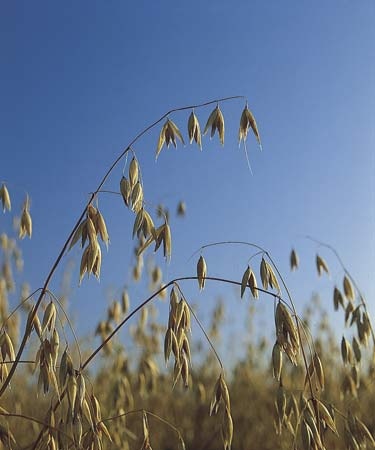oats
grain
 edible starchy grain of the oat plant (species Avena sativa), a cereal widely cultivated in the temperate regions of the world. The flowering and fruiting structure, or inflorescence, of the plant is made up of numerous branches bearing florets that produce the caryopsis, or one-seeded fruit.
edible starchy grain of the oat plant (species Avena sativa), a cereal widely cultivated in the temperate regions of the world. The flowering and fruiting structure, or inflorescence, of the plant is made up of numerous branches bearing florets that produce the caryopsis, or one-seeded fruit.The wild oat was first found in western Europe, apparently as a weed mixed with barley. Wild oats spread from there to other parts of the world. Common oats are grown in cool, temperate regions; red oats, more heat tolerant, are grown mainly in warmer climates. Among cereals, oats are second only to rye in ability to survive in poor soils. With sufficient moisture, oats will grow on soils that are sandy, low in fertility, or highly acidic.
Although oats are used chiefly as livestock feed, some are processed for human consumption, especially as breakfast foods. Rolled oats, flattened kernels with the hulls removed, are used mostly for oatmeal; other breakfast foods are made from the groats, kernels with husks removed, but unflattened. Oat flour is not generally considered suitable for bread but is used to make cookies and puddings. Oat grains are high in carbohydrates and contain about 13 percent protein and 7.5 percent fat. They are a source of calcium, iron, vitamin B1, and nicotinic acid. The grain is used as livestock feed in both pure form and in mixtures. The straw is used for animal feed and bedding. Oat plants provide good hay and, under proper conditions, furnish excellent grazing and make good silage (stalk feed preserved by fermentation). In industry oat hulls are a source of furfural, a chemical used in various types of solvents.
Leading oat-producing countries include the United States, Belarus, Russia, Kazakhstan, Canada, France, Poland, Finland, Germany, and Australia. The demand for oats has been somewhat reduced by competition from hybrid corn and alfalfa.
- Perugia, University of
- Perugino
- peruke
- Perun
- Perutz, Max Ferdinand
- Peruvian–Bolivian Confederation
- Peru, Viceroyalty of
- Peruzzi, Baldassarre
- Peruzzi Family
- Pervez Musharraf
- Pervomaysk
- Pervouralsk
- Perón, Eva
- Perón, Isabel
- Perón, Juan
- Pesaro
- Pescara
- Pescara, Fernando Francesco de Avalos, marchese di
- Pescennius Niger
- Peschiera del Garda
- Pescia
- Pesellino
- peseta
- Peshawar
- peshaṭ